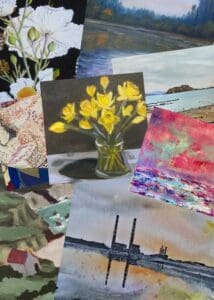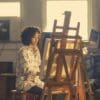On the need to differentiate between the structural and functional aspects of the psychology of art…
The psychology of art is a complex topic and this description serves only as an introduction to a ‘developing’ field of study. Psychology forms the basis of many aspects of life and art or expression of art in any form and especially through sculpture and painting is also based on psychological theories and understanding. The relation between psychology and art is almost inevitable; there can be no art without psychology and vice versa. The artist begins with a blank canvas on which he/ she projects his or her own psychological being and art remains as the medium of such projection. Thus art can best be defined as a medium through which an artist or creative individual projects his or her feelings and frustrations and deeper psychological necessities. This way art is intricately linked to psychology. Yet the psychology of art as a formal discipline has not found extensive recognition and has only very recently gained popularity in western universities.
The psychology of art is however a fascinating field of study as it analyzes the core of creativity and provides explanation for the mental processes of the artist in particular and the creative individual in general. Yet interestingly, psychology of art is not just limited to understanding the mental processes of the artist but also the mental processes involved in perceiving the art. Thus a psychology of art provides explanation and understanding of the phenomena of creativity, the mental processes of the artist, as well as the thought processes of the perceiver. It is comprehensive in its approach not only because of its range of explanation but also because art psychology involves explanations from different branches of psychology such as Gestalt psychology of perception, psychology of form and function/order and complexity, Jungian psychoanalysis, the psychology of attention and Experimental psychology as well as Freudian symbolism.
The psychology of art is interdisciplinary, successfully integrating art, architecture, philosophy (metaphysics and phenomenology), aesthetics, study of consciousness, visual perception, and psychoanalysis. From philosopher John Dewey to psychoanalyst Carl Gustav Jung, intellectuals of the 20th century influenced the emergence of a psychology of art that seemed to have moved beyond the mind processes of the artist to include the process of creation and also its perception examining art from biological, social, psychological and philosophical perspectives. Dewey and Jung both influenced the study of art within social and cultural contexts and are largely responsible for the understanding of art in its present form.
Art is obviously a creative process and is thus a deep psychological process as well. Art could well be explained with the theory of perception and as a cognitive process. The Gestalt theory of visual perception would offer one of the foremost explanations on art creation and perception. The Gestalt theorists were the 20th century psychologists who systematically studied perceptual processes in humans and some of the famous Gestaltists were Wolfgang Köhler, Kurt Koffka, Max Wertheimer, and Kurt Lewin. The principles of perception as given in Gestalt psychology focused on proximity or contiguity, similarity, continuity, closure, area/symmetry and figure and ground.
Thus Gestalists described perception as a process that involved not just the object but also the context as perception of objects is affected by what surrounds these objects so to Gestaltists, things are always ‘more than the sum of their parts’. As art is also primarily about perception, our perception of any art object would depend on these Gestalt principles as well and we tend to see continuity or closure or even perceive movement in static objects. Gestalt psychology has been used extensively to describe and understand ‘visual illusions’. For example, objects which are situated closer to each other will be perceived as forming a group. If you’ve seen some of these pictures that explain the principles of Gestalt, you’ll quickly understand that there is more to art than simple brush strokes; art is as much a process of perception (including illusion) as it is a process of creation. If an artist successfully creates a visual illusion, he is almost like a magician. Yet art has several dimensions in its study and explanation and from Gestalt understanding of form and structure that provides a ‘structural’ explanation of the organizational principles of art, we have to understand the ‘functional’ features of art as well. This in turn is provided by psychoanalysis and symbolism.
In the early 20th century Sigmund Freud pioneered the study of art in its psychoanalytic form by considering the artist as essentially a neurotic who deals with his psychic pressures and conflicts through his creative impulses. Freud was interested in the ‘content’ or subject matter of art that reflected the inner conflicts and repressed wishes of the artist and art to Freud as to any psychoanalyst today is considered as essentially a projection of the artist’s mind and thought process. Freud believed that unconscious desires and fantasies of the artist makes way from the internal and manifests as the external on canvas through art. Thus if an artist fantasizes about beautiful virtuous women, he paints angels in heaven as a sort of ‘sublimation’ of his deeper wish. Thus any art work is directly related to the artist’s inner world and his unconscious regions of the mind.
One school of art that was directly influenced by the Freudian theory and directly manifests the unconscious is Surrealism which began in the early 20th century, initially as an offshoot of a cultural movement, Dadaism. Surrealism emphasizes on the integration of art and life and with psychoanalytic influences focuses on the unconscious desires. From the psychology of Jacques Lacan to the philosophy of Hegel, Surrealism was largely shaped by philosophy, psychology and cultural changes and has been one of the most revolutionary movements in the history of art.
Some of its famous proponents were André Breton and more recently Salvador Dali. In fact Dali’s work could be seen as almost a visual representation of Freud’s emphasis on dream analysis, unconscious desires as well as hallucinations and free association. Sexual symbolism, an important part of Freudian analysis has been extensively used by surrealists. Freud and surrealism highlighted a closer link between madness, sexuality and art but this sort of portrayal met with some opposition as well. On the other hand, Carl Jung’s psychoanalysis and emphasis on art as a form of cultural expression was more acceptable to some artists and Jung remains as the most influential psychoanalyst in art history with his optimistic and constructive portrayal of art. According to Jung, art and other forms of creative endeavor could access the ‘collective unconscious’ and provide considerable insights on not just the process of creativity but also the cultural elements in the mind that are carried across generations. In Jungian psychology art as a psychological process would be an assimilation of the cultural experiences of the artist so it is accessible to an wider community.
Thus the psychology of art as it develops to a major discipline and area of study could be considered as having two distinct branches –
o Structural Psychology of Art – that which emphasizes on the ‘structural’ aspects of perceiving art through form, organization as understood with Gestalt principles and general emphasis on structure, also with the principles of physiology and visual perception
o Functional Psychology of Art – that which emphasizes on art as a creative process representing the ‘functional’ aspects or mental dynamics of the artist, the content rather than the form and could be understood with the insights of psychoanalysis and phenomenology.
The structural branch relates mainly to the perceiver and the process of perception of art and the functional branch relates to the artist and the process of creation of art. Both these dimensions would be equally important and complement each other in a comprehensive conceptual psychology of art.
Source by Saberi Roy




